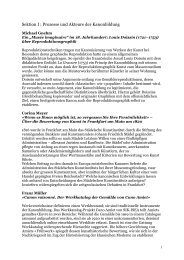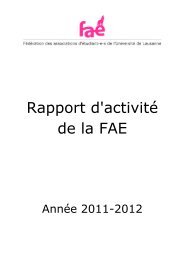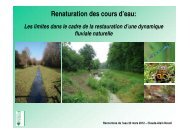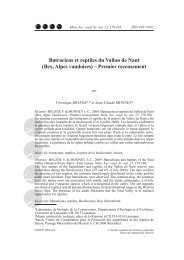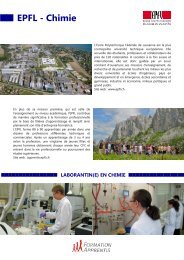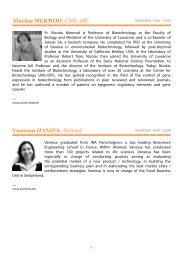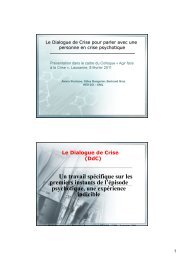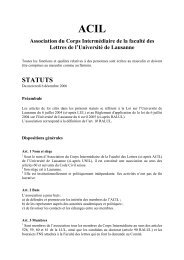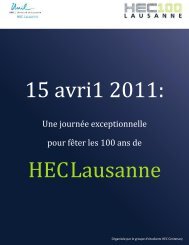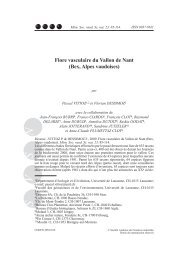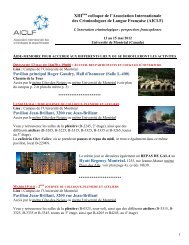a summary of the topics - Université de Lausanne
a summary of the topics - Université de Lausanne
a summary of the topics - Université de Lausanne
Create successful ePaper yourself
Turn your PDF publications into a flip-book with our unique Google optimized e-Paper software.
II.3 The mind and <strong>de</strong>ath<br />
The fact that <strong>the</strong> mind in all its complexity (imagination, emotion, curiosity, trust, creation,<br />
empathy) might be associated with a <strong>de</strong>fined physical area <strong>of</strong> <strong>the</strong> brain is somewhat<br />
reassuring for Cartesian science. Yet, it does not solve <strong>the</strong> fascinating question <strong>of</strong><br />
<strong>the</strong> purpose <strong>of</strong> <strong>the</strong> mind and <strong>of</strong> how and why <strong>the</strong> mind helps us to live and die. Regarding<br />
<strong>de</strong>ath, <strong>the</strong> Western scientific community has been recently confronted with narrations <strong>of</strong><br />
so-called near-<strong>de</strong>ath experiences (NDE), which are accounts <strong>of</strong> feelings and images perceived<br />
by individuals who were confronted to <strong>de</strong>ath after an illness or an acci<strong>de</strong>nt. These<br />
accounts are products <strong>of</strong> <strong>the</strong> mind that can be recalled and retold. They are usually presented<br />
as peaceful and appeasing. Moreover, since <strong>the</strong>y occur during direful events <strong>the</strong>y must<br />
be associated with a state <strong>of</strong> physical or psychological terminal stress.<br />
These phenomena have been variously explained by traditional and non-traditional sciences<br />
(parasciences) including (1) neurophysiology (e.g. <strong>the</strong> dysfunction <strong>of</strong> visual perception or hypoxia-related<br />
overproduction <strong>of</strong> endogenous opioids or dimethyltryptamine) ; (2) psychology<br />
and psychiatry (e.g. an emotional reaction to threat or a psychopathological disor<strong>de</strong>r<br />
such as heautoscopy) ; (3) psychology and spirituality (e.g. <strong>the</strong> psychological need which<br />
induces a cathartic effect in <strong>the</strong> individual in case <strong>of</strong> ultimate stress) ; or, (4) parapsychology<br />
(extra-sensory perceptions such as telepathy and clairvoyance). Whatever <strong>the</strong> mechanisms<br />
un<strong>de</strong>rlying <strong>the</strong>se accounts, <strong>the</strong> question remains as to <strong>the</strong>ir salutogenic importance to help<br />
experience more peacefully <strong>the</strong> ultimate stress <strong>of</strong> dying.<br />
While <strong>the</strong> interrogation seems pertinent at <strong>the</strong> level <strong>of</strong> <strong>the</strong> individual, it also has a collective<br />
dimension. Because mo<strong>de</strong>rn medicine can <strong>de</strong>clare <strong>the</strong> incurability <strong>of</strong> certain patients, it has<br />
<strong>the</strong> power to predict <strong>de</strong>ath. Hence, just as society has created <strong>the</strong> new category <strong>of</strong> <strong>the</strong> frail<br />
el<strong>de</strong>rly, medicine has created a new category <strong>of</strong> <strong>the</strong> “dying patient,” who too are forgotten,<br />
set asi<strong>de</strong>, and confined to special entities called “palliative care.” Nowadays in <strong>the</strong> West<br />
close to half <strong>of</strong> <strong>the</strong> people die in hospitals or nursing homes, <strong>of</strong>ten away from <strong>the</strong>ir families.<br />
They are variously taken care <strong>of</strong> by nursing staff alone, or nursing staff plus relatives that<br />
urgently come back to accompany <strong>the</strong> last moments <strong>of</strong> <strong>the</strong>ir beloved. In addition to this,<br />
patients <strong>of</strong>ten die after a period <strong>of</strong> coma during which <strong>the</strong> absence <strong>of</strong> communication<br />
opens <strong>the</strong> door to all kinds <strong>of</strong> imaginings and representations. There is a complex mixture<br />
<strong>of</strong> non-acceptance and resignation in both caretakers and relatives. For instance, caretakers<br />
may be frustrated because <strong>the</strong>y did not succeed in healing <strong>the</strong> patient. On <strong>the</strong> o<strong>the</strong>r si<strong>de</strong>,<br />
relatives may not be prepared to accept <strong>de</strong>ath. Not being prepared to face <strong>de</strong>ath may create<br />
anxiety and panic in <strong>the</strong> relatives, which may be very disturbing and difficult to handle by<br />
<strong>the</strong> medical staff. In contrast, having been thinking and meditating on it may help experience<br />
<strong>the</strong> situation more serenely and with more respect for <strong>the</strong> near-<strong>de</strong>ath person.<br />
11



